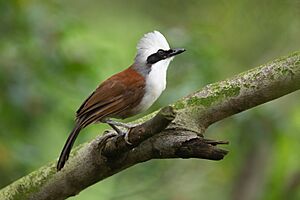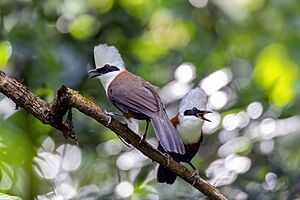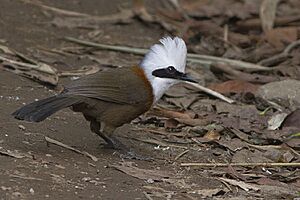White-crested laughingthrush facts for kids
Quick facts for kids White-crested laughingthrush |
|
|---|---|
 |
|
| Introduced, Singapore | |
| Conservation status | |
| Scientific classification |
The white-crested laughingthrush (Garrulax leucolophus) is a cool bird known for being very social and noisy! It belongs to a bird family called Leiothrichidae. You can find these birds living in forests and bushy areas, from the Himalayas all the way to Southeast Asia.
About Its Name
The white-crested laughingthrush is part of the Leiothrichidae family. This family was recently separated from the Old World babbler family. Its scientific name, Garrulax leucolophus, tells us a lot about it.
The word Garrulax comes from a Latin word meaning "to chatter." This fits because these birds are very vocal! Leucolophus comes from two Greek words: leukós meaning "white" and lophos meaning "crest." This describes its white crest perfectly.
Different Types of White-Crested Laughingthrushes
Scientists have found four main types, or subspecies, of this bird:
- G. l. leucolophus (the western type)
- G. l. patkaicus
- G. l. belangeri
- G. l. diardi (the eastern type)
There used to be another type, G. l. bicolor. But now it's considered its own species, the Sumatran laughingthrush. It looks different and has a shorter tail.
What It Looks Like
Like other birds in its group, the white-crested laughingthrush has a strong body. It has dark, strong legs and a thick beak. Its tail is rounded, and its feathers are very full.
This bird is about 30 centimeters (12 inches) long. Its tail is usually 13 to 15 centimeters (5 to 6 inches) long.
It's easy to spot because of its white head and the crest of feathers that stands up. It also has a wide, long black mask around its eyes. The back and lower body are a reddish-brown color. This color stands out against its white head, throat, and upper chest. The feathers on its tail and upper wings are a darker olive-brown. The back of its neck is light gray.
How Males, Females, and Young Birds Differ
Female white-crested laughingthrushes look very similar to males. However, females have a smaller crest. Their back feathers are also a bit duller. The gray color on the back of their neck is a little stronger.
Young birds, called juveniles, have a shorter crest and tail. Their eye mask is lighter, and the back of their neck is brownish. Their back feathers are also brighter.
Small Differences in Subspecies
The different subspecies have slight variations in their feathers:
- G. l. patkaicus has a darker, richer reddish-brown on its back.
- G. l. belangeri has white feathers that reach further down its belly. Its underparts are also paler.
- G. l. diardi has even more white on its belly and a brighter upper back.
Where It Lives
Native Home
The white-crested laughingthrush lives in many places. This means it's not in danger of disappearing. It naturally lives in these countries:
Each of the four subspecies lives in slightly different areas:
- G. l. leucolophus: Northern India, Nepal, Bhutan, Southern China (Tibet).
- G. l. patkaicus: Northeastern India, Bangladesh, Myanmar, Southern China (Yunnan).
- G. l. belangeri: Myanmar, Thailand.
- G. l. diardi: Myanmar, Thailand, Laos, Cambodia, Vietnam, Southern China (Yunnan).
New Places It Has Moved To
The white-crested laughingthrush is a popular pet bird. Some birds escaped or were set free during religious ceremonies. This is likely how G. l. diardi spread to Malaysia and Singapore in the 1970s and 1980s. The pet bird trade also brought them to the UK and US. However, there are no wild groups reported there.
In Malaysia, there are only a few left because of trapping. But in Singapore, they have settled in very well. They might even be taking over areas from native birds. These native birds are already struggling because their homes are being broken up. The laughingthrush is good at living in new places. This is because they are social and work together. They also live in large groups and can live in many different habitats. This includes parks, gardens, and damaged forests.
Its Favorite Places to Live
You can often find the white-crested laughingthrush in forests at the bottom of mountains, up to 1600 meters (about 5,250 feet) high. They like thick, wet, and shady thickets and bushes. They also like the edges and undergrowth of broadleaf secondary forests. These spots help them hide from predators and stay cool from the sun. They usually only come out of hiding to find food on the ground. They also love bamboo plants. Bamboo is great for building nests and provides good camouflage.
Behaviour
How They Talk to Each Other
White-crested laughingthrushes are very social birds. They usually live in groups of 6 to 12 birds. Sometimes, groups can even have up to 40 birds! These small groups can be very loud. One bird starts a call, and then others join in with a chorus.
They are called "laughingthrushes" because of their "loud cackling outbursts." These sounds often lead to quieter, more pleasant chattering. They make four different types of sounds. Most of their sounds are for social reasons. They use them to tell other birds where they are. They also warn each other about danger or strangers. Sometimes, they even call others to chase away different birds. They are known to be aggressive towards other groups or species.
What They Eat
Like other laughingthrushes, these birds eat many different things. They mostly eat small creatures without backbones. This includes beetles, spiders, flies, mealworms, caterpillars, snails, and leeches. But they also eat fruits, seeds, nectar, and even small reptiles and amphibians. This means snakes, lizards, and frogs. In Singapore, people have seen them eating human food and trash. One person even saw them asking humans for food scraps!
When they look for food, they search on the ground. They often do this in small groups. They hop from place to place. They use their beak to toss aside leaves and find small creatures hiding underneath.
Reproduction and Life Cycle

White-crested laughingthrushes start having babies when they are two years old. They breed several times between February and September. Their nests are shallow and shaped like a cup. They build them in bushes and trees, usually 2 to 6 meters (6 to 20 feet) high. They make the nests from bamboo leaves and grass, held together with twigs and stems.
Each nest holds 2 to 6 pure white eggs. Each egg weighs about 6.5 grams (0.2 ounces). Both parents take turns sitting on the eggs for 13 to 17 days. The male and female also share the job of keeping the chicks warm and feeding them. The chicks grow from being completely naked to looking like tiny adults in 14 to 16 days after hatching.
These jobs are not just for the parents! White-crested laughingthrushes are cooperative breeders. This means other birds help out. Sometimes, two females might share a nest. Three or more adults might take turns sitting on the eggs and feeding the chicks. These "helpers" are not always adults. Young birds from an earlier group of chicks sometimes help build the nest or feed their younger brothers and sisters.



